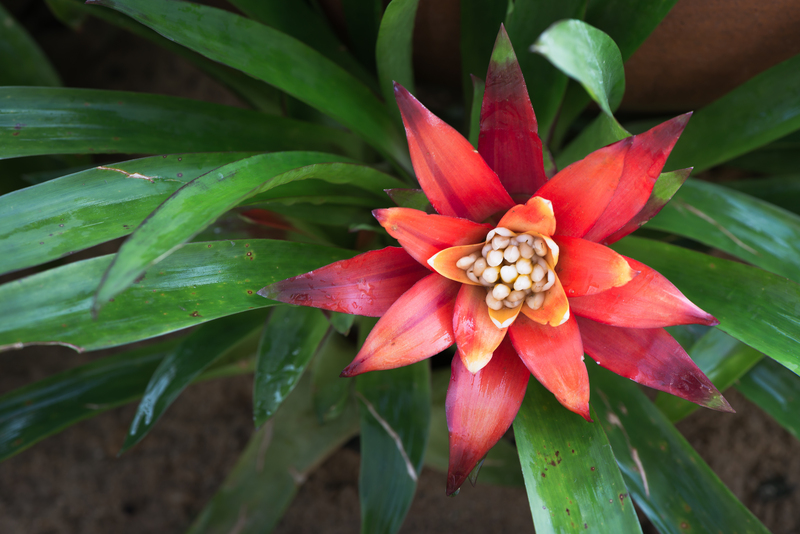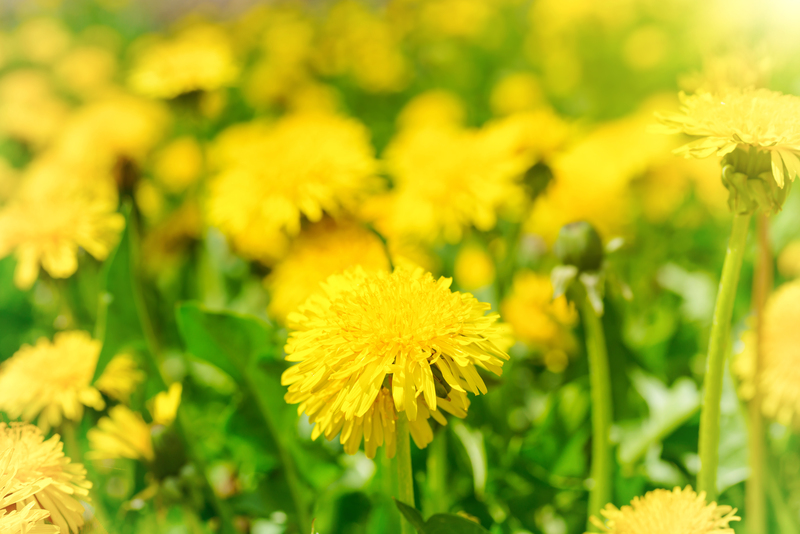Conquer Weeds with These Three Practical Tips
Posted on 28/08/2025
Conquer Weeds with These Three Practical Tips for a Healthy, Thriving Garden
Weeds can be the bane of any gardener's existence. These persistent invaders steal nutrients, water, and sunlight from your prized plants, undermining your hard work and garden ambitions. Luckily, there are effective, practical ways to defeat garden weeds without despairing or resorting exclusively to chemical solutions. In this comprehensive guide, you'll discover three detailed, science-backed strategies for weed control that will help you achieve a lush, weed-free landscape season after season.
Understanding Garden Weeds: Why They Are a Problem
Before diving into weed management methods, it's crucial to understand why garden weeds pose such a stubborn challenge. Weeds are simply unwanted plants that grow vigorously wherever they find space and opportunity. Their fast germination and deep, robust root systems enable them to outcompete desired plants for vital resources. Some common garden weeds include:
- Dandelion (Taraxacum officinale)
- Bindweed (Convolvulus arvensis)
- Crabgrass (Digitaria spp.)
- Chickweed (Stellaria media)
Left unchecked, weeds can:
- Reduce crop yields
- Harbor plant diseases and pests
- Affect plant aesthetics
- Consume soil nutrients and moisture
Weed prevention and control thus become vital for healthy gardens. Let's explore three practical approaches to conquer weeds and restore balance to your outdoor spaces.

1. Mulching: Your Garden's First Line of Defense Against Weeds
Mulching is one of the most powerful tools in the battle against weeds. By covering the soil surface, mulch prevents sunlight from reaching weed seeds, drastically reducing their germination rates. Here's why mulching is among the top weed control methods for home gardeners and landscapers alike.
Types of Mulch to Suppress Weeds
- Organic Mulches: These include wood chips, shredded leaves, compost, straw, grass clippings, or bark. They not only block weed growth but also enrich the soil as they decompose.
- Inorganic Mulches: Options such as landscape fabric, black plastic, gravel, or stones don't decompose and provide long-lasting weed barriers, though they don't improve soil quality.
How to Use Mulch Effectively for Weed Control
- Prepare the Area: Start by hand-pulling existing weeds or using a hoe to remove them down to the root.
- Apply a Thick Layer: Spread mulch in a layer at least 2-4 inches deep for organic materials and 1-2 inches for inorganic options. Thinner layers may allow weeds to breach the surface.
- Keep Mulch Off Stems: Space mulch a few inches away from plant stems and tree trunks to prevent rot.
- Maintain Mulch Regularly: Top up organic mulch as it decomposes throughout the growing season to keep a consistent layer.
Benefits:
- Blocks sunlight to smother existing weeds and prevent seed germination.
- Retains soil moisture, reducing watering needs.
- Moderates soil temperature and improves soil structure (with organic mulch).
- Beautifies garden beds with neat, uniform coverage.
Mulching Mistakes to Avoid
- Applying too thin a layer, allowing weeds through.
- Using poor quality mulch that contains weed seeds.
- Letting mulch pile up against plant stems, causing disease.
Smart mulching can be your most effective strategy to conquer weeds naturally while nurturing your plants.
2. Manual and Mechanical Removal: Tackling Weeds at the Root
As much as prevention is important, all gardeners inevitably find weeds that need to be eliminated, especially in the early stages of infestation. Hand-pulling and mechanical methods remain among the most reliable and eco-friendly ways to remove weeds in both flower beds and vegetable gardens.
Tips for Effective Manual Weed Removal
- Weed When Soil is Moist: After rainfall or watering, soils are softer and weed roots release more easily.
- Pull from the Base: Grab weeds as close to the soil line as possible and tug gently to extract the entire root system, especially for perennial weeds like dandelions.
- Regular Attention: Inspect gardens weekly so that you can catch weeds before they mature and spread seeds.
Tools for Mechanical Weed Removal
Several specialized tools can make weed removal more efficient:
- Hoes: Stirrup or scuffle hoes are excellent for slicing off young weeds at or just below the soil surface.
- Cultivators: These tools break up soil and dislodge weed seedlings in larger garden areas.
- Weeding Knives: Ideal for removing deep-rooted weeds in tight spaces without disturbing nearby plants.
- Wheel Hoes: Great for larger-scale vegetable plots, allowing quick removal between rows.
Don't underestimate the power of manual labor! Removing weeds by hand ensures you get the roots, minimizing the chances of regrowth.
Advantages of Manual and Mechanical Weed Control
- No chemical residues left in soil or on crops.
- Selective targeting ensures beneficial plants remain safe.
- Physical disruption can reduce the weed seed bank over seasons.
Tips for Long-Term Success
- Start early in the season before weeds can flower and set seed.
- Always dispose of uprooted flowering or seeding weeds away from your garden to prevent re-infestation.
- Implement mulching or dense plantings immediately after weeding to hinder new growth.
Regular and strategic manual weed management is a cornerstone of organic, sustainable gardening. Conquer garden weeds before they become an overwhelming problem, and you'll spend less time fighting them later in the season.
3. Smothering and Preventive Planting: Outcompete Weeds with Strategic Plant Choices
Sometimes, the best way to control weeds is to "crowd them out." You can use strategic preventive planting and smothering techniques to deny weeds the space, sunlight, and resources they need to thrive.
Smothering Weeds with Barriers
Beyond mulch, several barriers can starve weeds of light and space:
- Cardboard or Newspaper: Place sheets directly over cleared soil, then cover with mulch. This biodegradable barrier blocks light and breaks down over time.
- Landscape Fabric: Durable, permeable material that lets water through but stops weeds from sprouting.
- Opaque Plastic: Solarize beds before planting by covering with clear or black plastic for several weeks to kill weed seeds via heat.
Barriers not only suppress existing weeds, but when paired with mulch or cover crops, prevent future outbreaks as well.
Preventive Planting: Grow a Living Weed Barrier
Dense, healthy plantings leave little room for weeds to take hold. Try these approaches:
- Crowd Planting: Space your plants closer together, as appropriate for each species, to quickly establish leafy canopies that shade soil.
- Groundcovers: Low-growing plants like creeping thyme, clover, periwinkle, or sweet woodruff provide attractive matting that chokes out weed growth.
- Cover Crops: In vegetable gardens, sow nitrogen-fixing plants (like clover or vetch) during off-seasons to outcompete weeds, enrich the soil, and break disease cycles.
- Interplanting: Alternate early-growing plants (lettuce, radishes) with slower crops (tomatoes, squash) to keep soil covered year-round.
Benefits of Planting to Prevent Weeds
- Natural competition suppresses weed emergence.
- Maintains soil structure and moisture.
- Reduces need for mulching or auxiliary weed controls over time.
- Improves biodiversity and plant health.
By leveraging nature's own strategies, you not only control weeds organically but also create a more resilient and attractive landscape.
Pro Tips: Integrated Weed Management for Lasting Results
The key to conquering weeds for good is using a combination of the techniques above--an approach known as Integrated Weed Management (IWM). Here are some proven strategies:
- Monitor regularly: The earlier you spot weeds, the easier they are to control.
- Avoid soil disturbance: Tilling brings buried weed seeds to the surface. Minimize deep digging where possible.
- Keep edges tidy: Mow or edge pathways, borders, and fence lines to prevent weed spread into beds.
- Stay vigilant after rain: Rain encourages weed germination--check and weed soon after wet weather.
- Encourage healthy soil: Fertile, well-aerated soil gives your plants a head start over weeds.
How Often Should You Weed?
Consistency is key. A small session of hand weeding every week or two in spring and summer beats marathon sessions later in the year. Over time, you'll see a decline in the overall weed population as your efforts take effect.
When to Consider Chemical Weed Control
While the above weed prevention tips are generally sufficient for most home gardens, there may be occasions where herbicides are necessary--such as severe infestations or invasive species that can't be controlled manually. If you choose to use herbicides:
- Always follow the manufacturer's instructions.
- Use targeted, non-residual products where possible.
- Avoid spraying on windy or rainy days to minimize drift and unintended damage.
- Wear gloves, long sleeves, and eye protection when applying chemicals.
Remember, chemical methods should be a last resort. Regular mulching, hand-weeding, and dense planting are safer, more eco-friendly ways to achieve long-term weed defense.

Frequently Asked Questions About Weed Control
Q: What is the best natural way to control weeds?
A: Combining mulching, manual weed removal, and dense planting to minimize bare soil is the most effective natural approach. Persistence and variety in your methods will yield the best results over time.
Q: When is the best time to pull weeds?
A: Pull weeds when the soil is moist (after rain or watering) for easier root removal. Early spring, before weeds go to seed, is ideal.
Q: How do I prevent weeds in the vegetable garden?
A: Use thick organic mulch, plant vegetable rows close together, sow cover crops during off-seasons, and weed regularly while plants are young.
Q: Can I compost weeds?
A: Only compost weeds that have not gone to seed and do not have persistent roots (like bindweed or nutsedge), as those may survive and spread through compost.
Conclusion: Cultivate a Weed-Free Garden with Smart, Practical Strategy
Conquering weeds is not about a single quick fix--it's about adopting a handful of time-proven practices and staying consistent. By mastering mulching, regularly weeding by hand or with tools, and implementing preventive planting, you'll enjoy a garden that's not only free of weeds but also healthier, more vibrant, and easier to maintain for years to come.
- Start with good mulching habits.
- Tackle weeds early and often.
- Let plant density and barriers do their part.
With these three practical tips to defeat weeds, your dream garden is finally within reach. Happy gardening!



